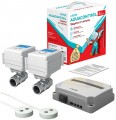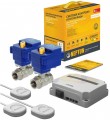In box
Main system components supplied in the kit.
The finished delivery kit includes three components: a control unit (CU), a leakage sensor(s) and a special ball valve(s). At the same time, both
control units(including those
built into the valve) and
valves can be sold completely separately. Let's take a closer look at each component:
- Control unit. The “brain” of the system, is directly responsible for its functioning: it receives signals from sensors and controls the valves. In this case, we mean a control unit made in the form of a separate device. Installing such a system is somewhat more complicated than in the case of a valve with a built-in control unit — it is necessary to ensure that the control unit is connected not only to the sensors but also to the valve(s). On the other hand, the control module can be placed in a convenient place. In addition, this kind of arrangement is optimal if you need to shut off several points in the water supply system at once: one common external unit for several valves, as a rule, is cheaper than several valves with built-in control units.
—
Cvalves with control unit. A control unit built directly into the ball valve is responsible for shutting off the water. This design makes it possible to reduce the dimensions of the system and
...the total number of components in it, and, as a result, significantly simplifies installation. On the other hand, a built-in control unit is usually responsible only for its own valve and does not allow the connection of additional ones. So it makes sense to pay attention to this option mainly in three cases: either if you need to cover only one point, if compactness and a minimum number of components are crucial, or if there are difficulties with installing a remote control unit.
— Ball valve. A special valve driven by an electric motor shuts off the water supply based on a signal from the control unit. Note that the kit usually includes a small number of valves — no more than 3, while control units can support a larger number. This is done so that the customer does not overpay for extra valves when purchasing a set. If the standard equipment is not enough, additional valves can be purchased separately.
— Leakage sensor. A sensor that reacts to contact with water. When water gets on the touch surface, such a sensor sends a signal to the central unit, reporting a leak. Note that many systems allow the connection of more sensors than are supplied in the kit. The sensors themselves can use both wired and wireless connections to the control unit; some kits support both options at once. See “Sensor connection” for details.Closing time
The speed of the valve responds to an alarm signal. The faster the valve closes, the less water will spill from the depressurized circuit. A good response time is 2.5 s. For entry-level and mid-level leak protection systems, the normal response time is 5 to 7 seconds.
Max. pressure
The maximum water pressure for which the valve of the water leak detection system is designed. Obviously, it is worth choosing according to this parameter, taking into account the pressure at the installation site; however, it's okay to take a certain reserve in case of emergency. So, for a conventional city water supply system, the nominal pressure of which is 4 – 6 bar, it is advisable to use a valve for at least 8, or even 10 – 12 bar.
Torque
The torque developed by the electric drive of the ball valve — in other words, the force supplied by the motor to the valve.
For normal operating conditions, this parameter is not of fundamental importance — more precisely, it is selected by the manufacturer in such a way that the crane can be guaranteed to perform its task, taking into account the diameter of the pipe (larger diameter requires more effort) and other parameters. But if there is a risk of getting dirt into the mechanism, then in such cases
a high torque is desirable. As for specific values, in the "weakest" valves it is about 6 – 7 Nm, and in the most powerful — from 30 Nm or more.
Max. liquid temp
Maximum fluid temperature allowed for system components.
The standard temperature in centralized hot water supply systems is about 60 °C. If hot water is supplied from a boiler or a building's boiler room, it may well be hotter — up to 90 °C. With all this, among water leak detection systems there are options for higher temperatures —
100 °C or more. Such systems are indispensable in specific situations — for example if you need to protect a heating system or a pipeline with hot process fluid. And even in relatively simple conditions, high-temperature resistance can come in handy: it provides an additional guarantee in case of failures and malfunctions.
Manual valve closing
Ability to close and open the valve
manually, regardless of the state of the system and sensor signals.
This function allows you to use the leak detection system as a general valve that controls the flow of water into its part of the water supply system. This can be useful both in case of a malfunction of the detection system (for example, the battery in the wireless sensor has run out, or one of the sensors gave a false signal) and in quite regular situations — for example, if you need to turn off the water for a long absence.
Backup battery
The presence
of a backup power source in the design of the device. Such a source is needed when the main power is not available; thanks to this, the system remains operational even during power outages. The classic backup power option is batteries in devices powered by the mains. For a long time, such batteries are not enough, but at least they allow you to detect failure without losing protection.
Valve warranty
The warranty period for the valve provided by the manufacturer.
The nuances of the warranty conditions may be different, but the general principle is unchanged: if during the specified period the product shows defects that arose due to the fault of the manufacturer, or it fails for the same reason, the buyer will receive compensation (in the form of a refund, free replacement of the product or free repair). Specific warranty periods can vary from 1 year in relatively simple and inexpensive models to 7 or even
10 years in advanced solutions. Some high-end systems are even sold with a so-called
lifetime warranty — it is unlimited and is valid until the product fails for reasons beyond the control of the manufacturer.

